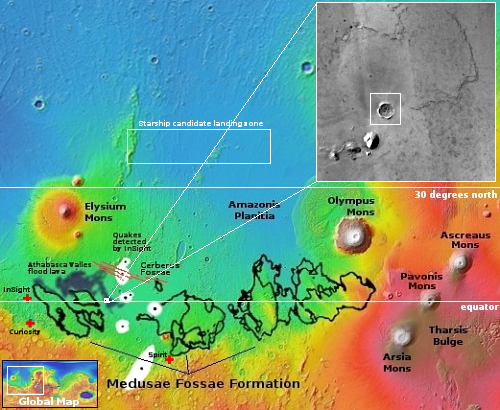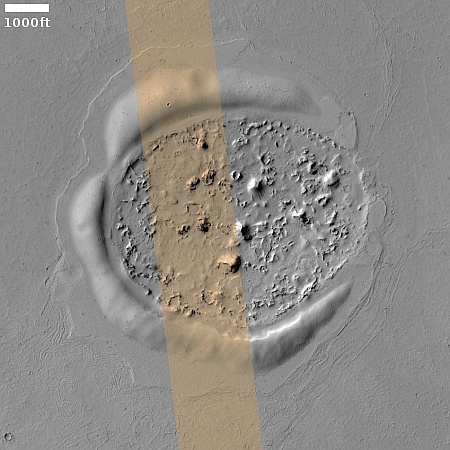Bubbling lava frozen in a Martian crater
Cool image time! The picture to the right, cropped, reduced, and sharpened to post here, was taken on June 23, 2025 by the high resolution camera on Mars Reconnaissance Orbiter (MRO). This one-mile-wide unnamed crater was a featured image last week by the science team. As noted in the caption, written by Chris Okubo of the U.S. Geological Survey:
This area was covered by a large flood of lava, which we see as the generally flat areas surrounding the crater. As the lava flowed across, some of it flowed into this crater through a low spot along the crater rim.
Once in the crater, the lava heated ground water or ground ice in the floor, causing the water to boil and turn into steam. This steam then exploded through the overlying lava and created small, ring-shaped formations. These are called ”rootless cones,” and they record the presence of ground water or ground ice in the crater floor at the time of the lava eruptions.
In other words, when this crater was flooded with hot lava, it was filled with ice or water. That fact is significant because of the crater’s location, as shown in the overview map below.

The white dot marks the location, inside the Athabasca flood lava flow. Athabasca is thought to the youngest major volcanic event on Mars, estimated to have occurred only about 600 million years ago. If you look closely at the inset, you can see the leading edge of that flow’s last deposit on the right. It is this wave of lava that apparently filled the crater.
What is significant about this location is that it is in the dry tropics of Mars, where no near surface ice is found. In fact, the crater is practically on the equator. Yet, 600 million years ago this crater had ice/water in it that when covered with hot lava bubbled up to form those cones and protrusions.
We know that the tropics of Mars today were not its tropics in the past. The red planet’s rotational tilt varies much more than Earth’s, from 11 to 60 degrees. At present that tilt is similar to Earth’s at 25 degrees inclination. When it was at the extremes however those tropics were located in the mid-latitudes, where today Mars has plenty of glaciers and near-surface ice.
The crater is thus evidence of Mars’ long slow loss of water. As its inclination swung up and down, the ice along the planet’s waist was sublimated away, leaving today’s equatorial regions dry. This hypothesis is further supported by the glacial layering seen in today’s mid-latitudes. As the inclination swings back and forth and the glaciers shrink and grow, each new growth period is shorter. There is less snowfall deposited to sustain it.
On Christmas Eve 1968 three Americans became the first humans to visit another world. What they did to celebrate was unexpected and profound, and will be remembered throughout all human history. Genesis: the Story of Apollo 8, Robert Zimmerman's classic history of humanity's first journey to another world, tells that story, and it is now available as both an ebook and an audiobook, both with a foreword by Valerie Anders and a new introduction by Robert Zimmerman.
The print edition can be purchased at Amazon or from any other book seller. If you want an autographed copy the price is $60 for the hardback and $45 for the paperback, plus $8 shipping for each. Go here for purchasing details. The ebook is available everywhere for $5.99 (before discount) at amazon, or direct from my ebook publisher, ebookit. If you buy it from ebookit you don't support the big tech companies and the author gets a bigger cut much sooner.
The audiobook is also available at all these vendors, and is also free with a 30-day trial membership to Audible.
"Not simply about one mission, [Genesis] is also the history of America's quest for the moon... Zimmerman has done a masterful job of tying disparate events together into a solid account of one of America's greatest human triumphs."--San Antonio Express-News
Cool image time! The picture to the right, cropped, reduced, and sharpened to post here, was taken on June 23, 2025 by the high resolution camera on Mars Reconnaissance Orbiter (MRO). This one-mile-wide unnamed crater was a featured image last week by the science team. As noted in the caption, written by Chris Okubo of the U.S. Geological Survey:
This area was covered by a large flood of lava, which we see as the generally flat areas surrounding the crater. As the lava flowed across, some of it flowed into this crater through a low spot along the crater rim.
Once in the crater, the lava heated ground water or ground ice in the floor, causing the water to boil and turn into steam. This steam then exploded through the overlying lava and created small, ring-shaped formations. These are called ”rootless cones,” and they record the presence of ground water or ground ice in the crater floor at the time of the lava eruptions.
In other words, when this crater was flooded with hot lava, it was filled with ice or water. That fact is significant because of the crater’s location, as shown in the overview map below.

The white dot marks the location, inside the Athabasca flood lava flow. Athabasca is thought to the youngest major volcanic event on Mars, estimated to have occurred only about 600 million years ago. If you look closely at the inset, you can see the leading edge of that flow’s last deposit on the right. It is this wave of lava that apparently filled the crater.
What is significant about this location is that it is in the dry tropics of Mars, where no near surface ice is found. In fact, the crater is practically on the equator. Yet, 600 million years ago this crater had ice/water in it that when covered with hot lava bubbled up to form those cones and protrusions.
We know that the tropics of Mars today were not its tropics in the past. The red planet’s rotational tilt varies much more than Earth’s, from 11 to 60 degrees. At present that tilt is similar to Earth’s at 25 degrees inclination. When it was at the extremes however those tropics were located in the mid-latitudes, where today Mars has plenty of glaciers and near-surface ice.
The crater is thus evidence of Mars’ long slow loss of water. As its inclination swung up and down, the ice along the planet’s waist was sublimated away, leaving today’s equatorial regions dry. This hypothesis is further supported by the glacial layering seen in today’s mid-latitudes. As the inclination swings back and forth and the glaciers shrink and grow, each new growth period is shorter. There is less snowfall deposited to sustain it.
On Christmas Eve 1968 three Americans became the first humans to visit another world. What they did to celebrate was unexpected and profound, and will be remembered throughout all human history. Genesis: the Story of Apollo 8, Robert Zimmerman's classic history of humanity's first journey to another world, tells that story, and it is now available as both an ebook and an audiobook, both with a foreword by Valerie Anders and a new introduction by Robert Zimmerman.
The print edition can be purchased at Amazon or from any other book seller. If you want an autographed copy the price is $60 for the hardback and $45 for the paperback, plus $8 shipping for each. Go here for purchasing details. The ebook is available everywhere for $5.99 (before discount) at amazon, or direct from my ebook publisher, ebookit. If you buy it from ebookit you don't support the big tech companies and the author gets a bigger cut much sooner.
The audiobook is also available at all these vendors, and is also free with a 30-day trial membership to Audible.
"Not simply about one mission, [Genesis] is also the history of America's quest for the moon... Zimmerman has done a masterful job of tying disparate events together into a solid account of one of America's greatest human triumphs."--San Antonio Express-News



When red Mars hits your eye
like a big pizza pie…
And then ol’ Jed, his shootin’ wasn’t nice
And up through the ground come a bubblin’ ice
Water, that is
Agua Vita; Martian Gold